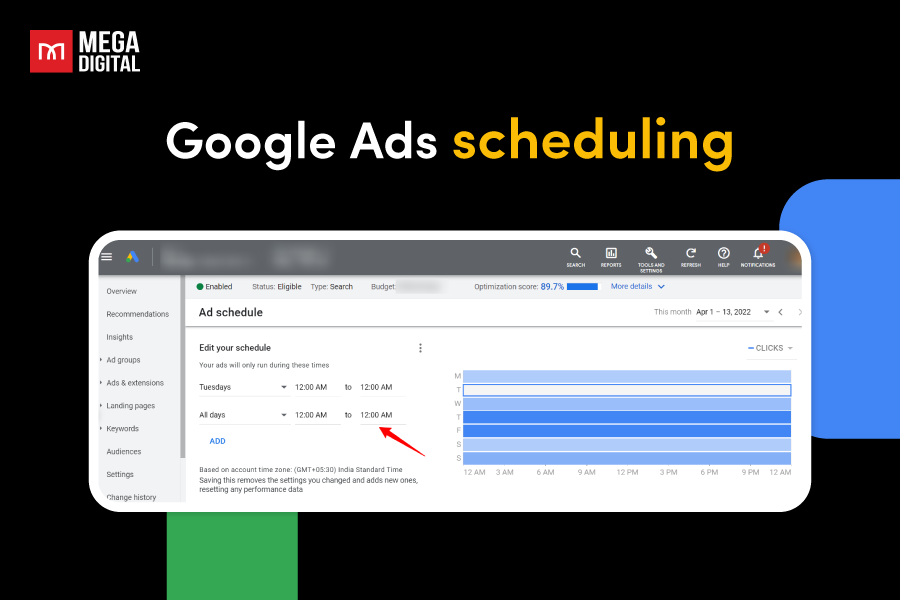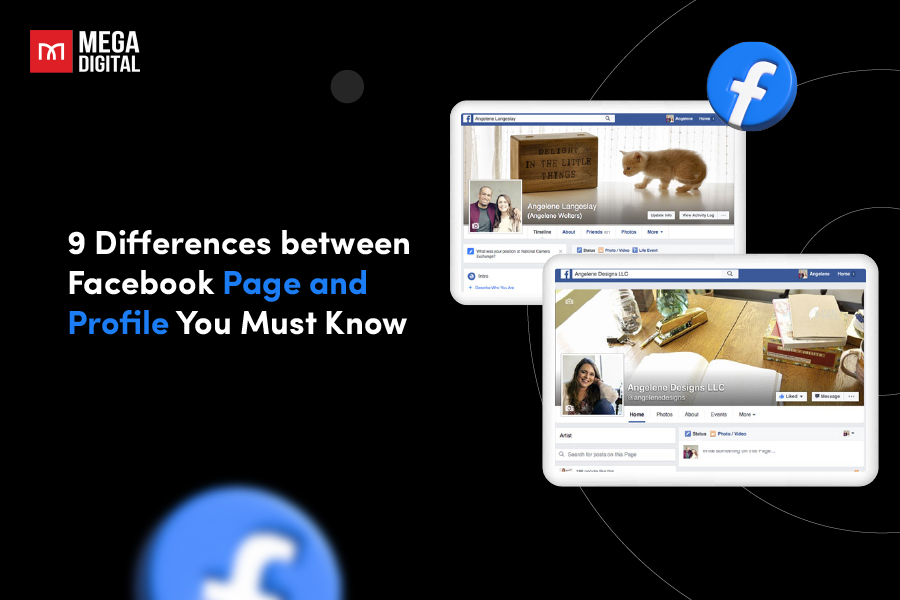Are you running Facebook Ads for your eCommerce business? If you already did it, it’s great. But to truly tap into its potential and see remarkable results, it’s crucial to have the right strategies in place. This blog post will guide you through the ins and outs of eCommerce Facebook Ads, helping you navigate this powerful advertising platform and boost your online sales.
Contents
Is Facebook Ads Still The Tool for eCommerce in 2025?
After analyzing over 1000 eCommerce ad campaigns of our clients, we found that Facebook Ads continue to be a viable choice for eCommerce brands in 2025. However, the success of these ads now relies much more heavily on high-converting ad creatives and copies. The deep targeting such as behaviors and interests aren’t nearly as profitable as they used to be.
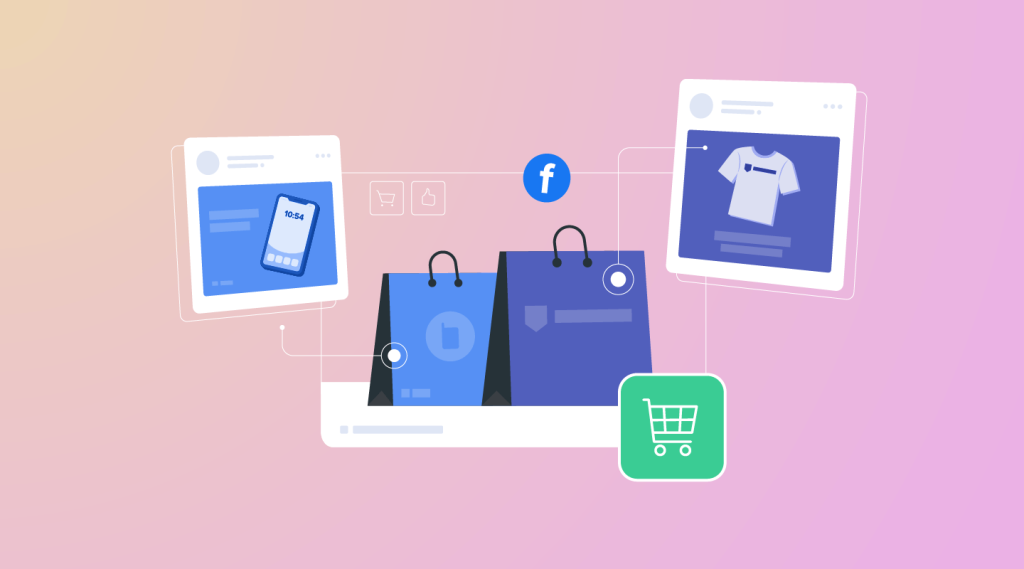
Nowadays, content is king. The quality of your ad content – the images, videos, and copy you use – can significantly impact the performance of your ads. Furthermore, Facebook’s seamless integration with popular eCommerce platforms makes it an indispensable tool for any eCommerce business looking to boost their online presence and drive conversions.
If you want to succeed with using Facebook Ads for an eCommerce store, don’t go anywhere because I’m about to show you strategies to scale up your eCommerce store with Facebook Ads.
10 Strategies for Improving Your eCommerce Store Conversions
There are many different Facebook eCommerce strategy options. But let’s take a look at 10 of the most effective strategies for eCommerce in 2025, by Mega Digital.
#1 Take advantage of different ad formats
Different ad formats can cater to different user preferences and can showcase your products in unique ways. This can lead to increased engagement and higher conversion rates. Experiment with various ad formats that work well for eCommerce, like carousel ads, dynamic product ads, or collection ads. Each format has its own strengths and can be used to highlight different features of your products.
For example, ASOS, a British online fast-fashion and cosmetic retailer company, uses carousel ads on Facebook to showcase multiple shoe products in a single ad, allowing users to see a range of products without having to leave the platform.
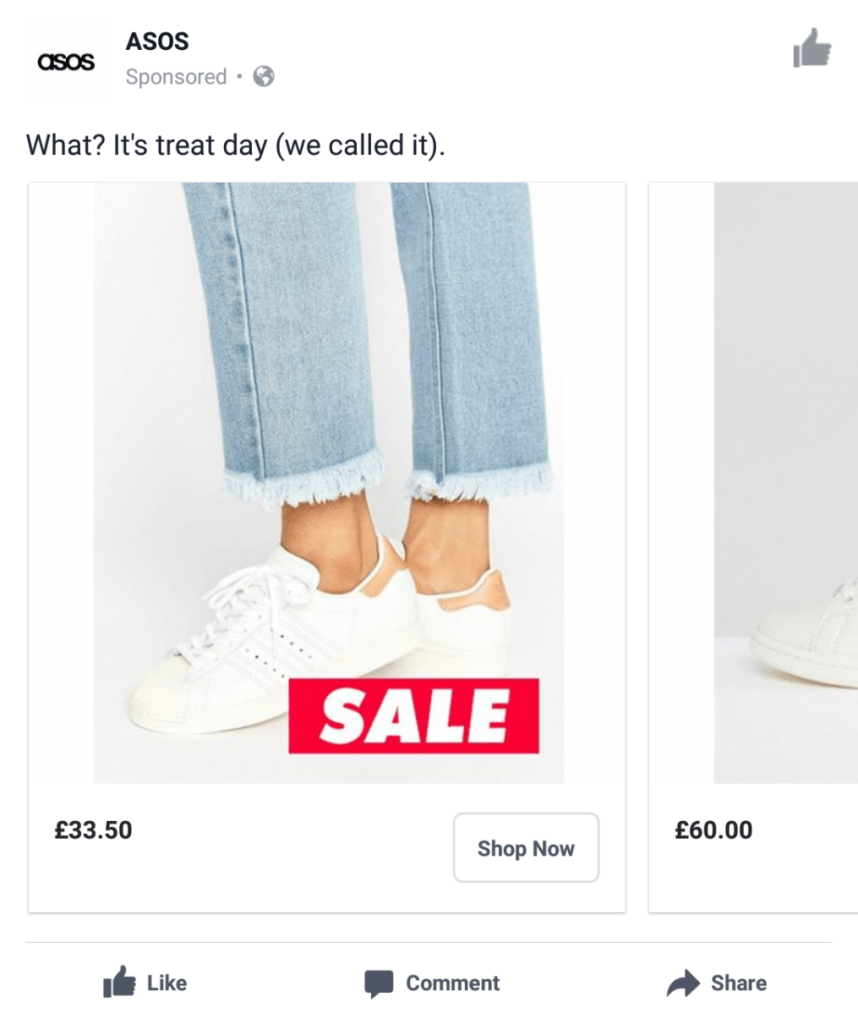
#2 Use faces on images/videos
Human faces in ads can create a sense of connection and trust, making your brand more relatable. This can significantly improve engagement and conversion rates. When creating your ad creatives, try to include images or videos that feature people using or interacting with your product.
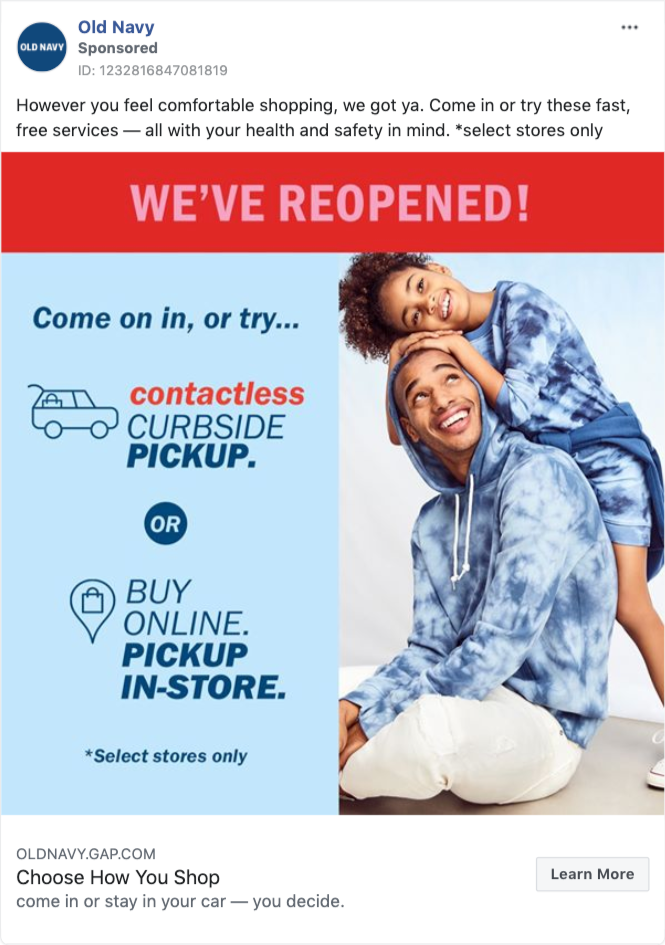
#3 Write killer ad copy
Compelling ad copy can effectively communicate the value of your product and persuade potential customers to make a purchase. It’s crucial to highlight the unique selling points of your product and how it can solve a problem or meet a need for your target audience. Spend time crafting persuasive, benefit-focused ad copy for your campaigns.
For example, Everlane, a clothing brand, pays attention to what’s going on in the world around it. That means that it can publish ads that are more relevant to its target audience. During the COVID-19 pandemic, when people were spending more time at home, Everlane reminded people that with their “Party of One” dress, they could still look good on their own.
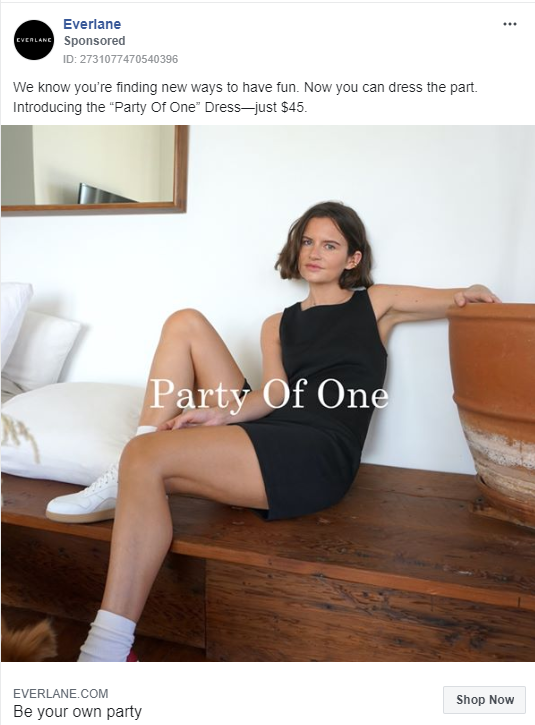
#4 Use broad targeting
While specific targeting can help reach a niche audience, broad targeting allows your ads to be shown to a wider audience, increasing the chances of discovering new potential customers. Facebook’s algorithm excels at finding the right people for your products by distributing ads based on users’ interaction behavior. It identifies users who interact with similar ads and targets them, thereby enhancing the reach of your products.
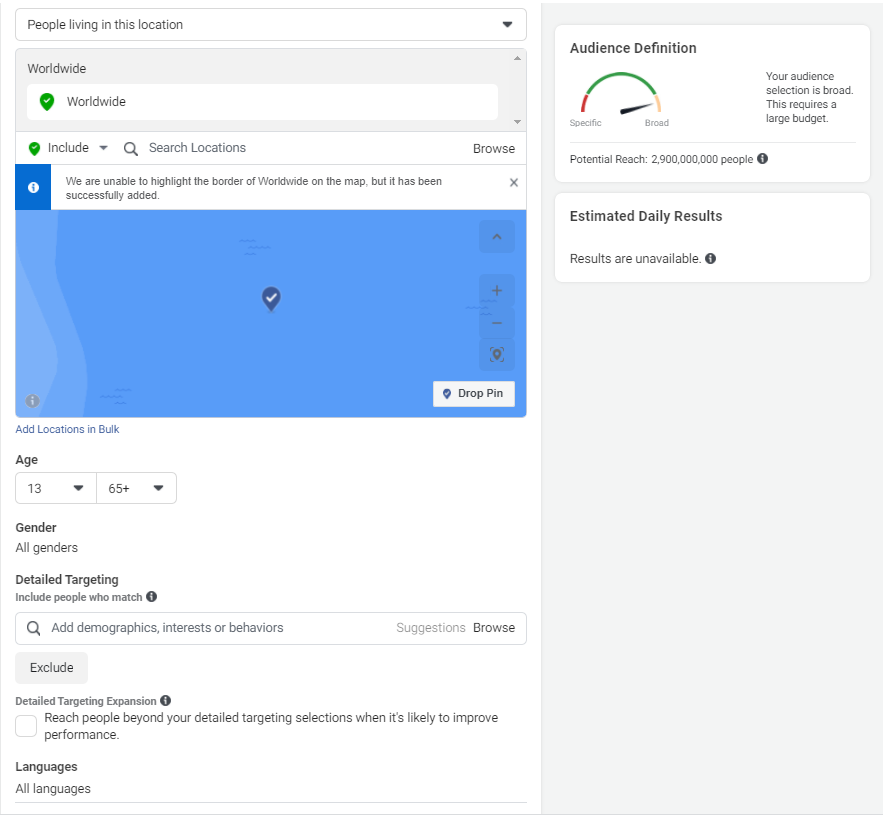
In Facebook Ads Manager, you can set these broad targeting parameters: location, language, and age. This approach allows Facebook’s algorithm to do the heavy lifting and find the right audience for your products.
#5 Build high-converting landing pages
Your landing page is where the conversion happens. It should be visually appealing, easy to navigate, and aligned with your ad creative.
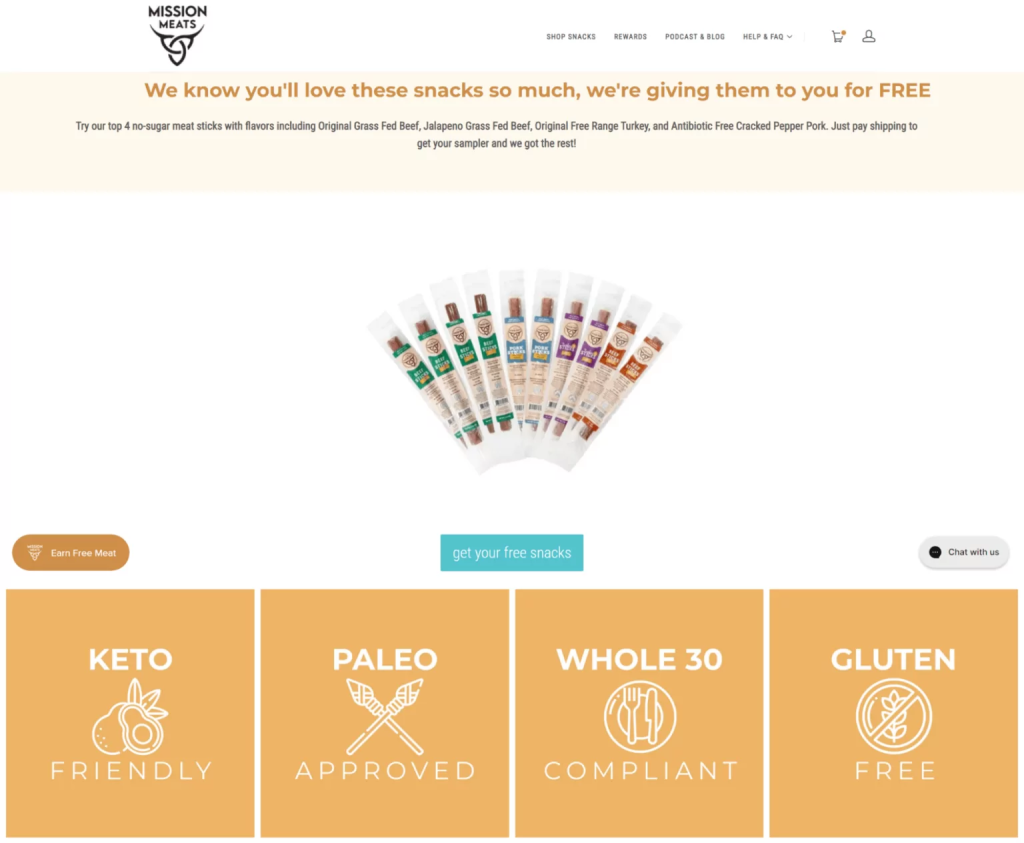
Look at this example from Mission Meats. Mission Meats makes healthy, grass-fed beef snacks and uses Facebook to advertise their promo, wherein shoppers can receive 10 beef sticks for free and only have to pay for shipping and handling.
The ad then redirects to a landing page, where a straightforward headline and copy outlines the promo and included snack flavors. An image of the offer appears front and center, and its CTA compels shoppers to take advantage of the enticing opportunity.
#6 Run retargeting campaigns with great consideration
Retargeting can remind interested customers of your products and nudge them towards conversion. It’s a powerful way to stay top-of-mind and recover potential customers who didn’t convert on their first visit.
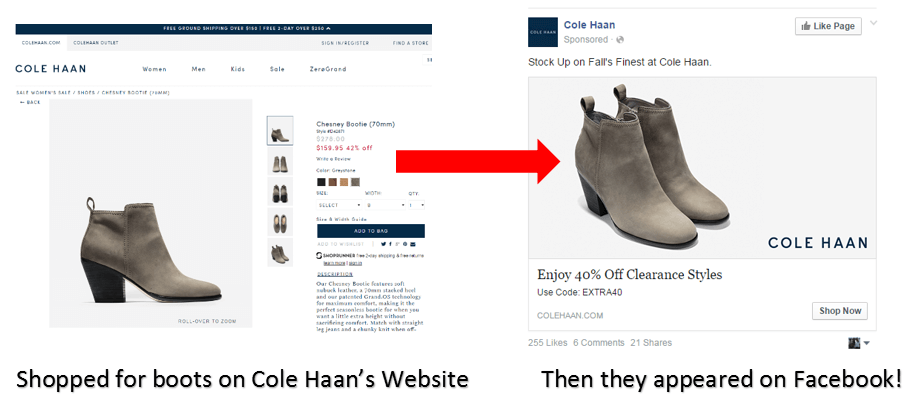
Use retargeting campaigns to re-engage users who have shown interest in your products. Use Facebook’s Custom Audiences feature to set up effective retargeting campaigns.
However, these campaigns should be run with care to avoid overwhelming your audience with too many ads.
#7 Optimize for mobile devices
More and more shopping is being done on mobile devices. With the increasing prevalence of mobile shopping, you must ensure your ads and landing pages are optimized for mobile devices. This means they should look good and load quickly on all screen sizes, and the checkout process should be easy to complete on a mobile device.
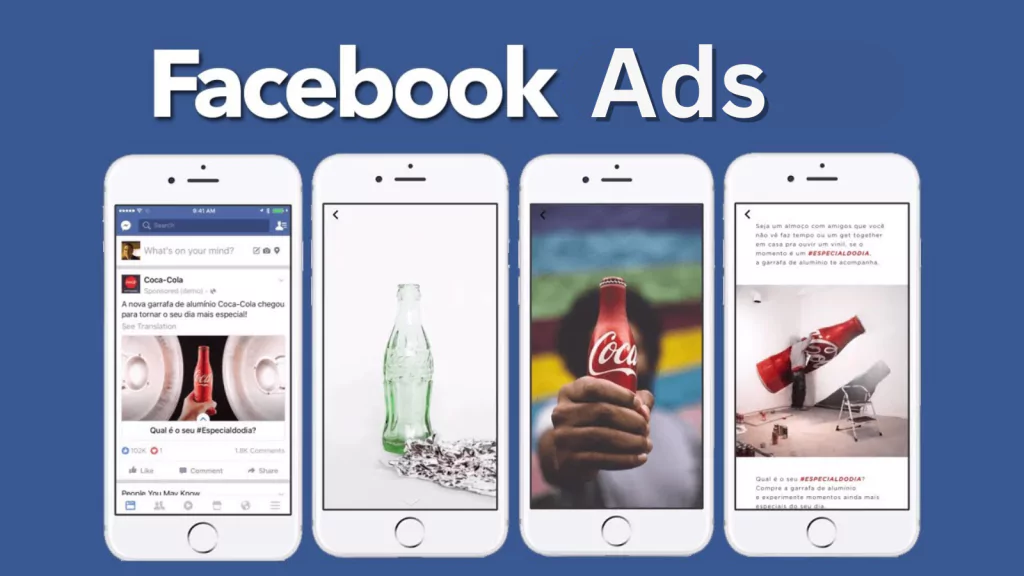
#8 A/B testing to determine high-performing ads
A/B testing is about creating two or more versions of an ad (Ad A and Ad B) that are identical in all aspects except for one variable that you want to test.
As consumer preferences and trends for eCommerce evolve, A/B testing allows you to constantly refine your ads and stay ahead of the curve. Or sometimes, unexpected variations outperform your initial assumptions. Testing helps discover these hidden gems.
By testing different ad elements before scaling up your campaign, you minimize the risk of wasting budget on ads that don’t perform well.
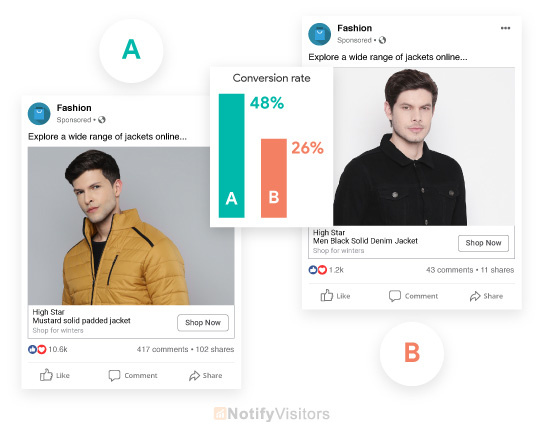
#9 Use User-Generated Content (UGC)
In case you don’t know, UGC is content created by users rather than the brand itself. This can include customer reviews, social media posts, blog posts, and more. UGC is influential in shaping consumers’ buying decisions. In fact, 80% of consumers say that UGC impacts their buying decisions.
You can use user-generated content to make your followers feel proud of their work, generate more shares, and shed new light on your brand.
IKEA’s Soft Toy Drawing Competition is a great example. IKEA’s competition not only generated a lot of user engagement (690 Likes, 153 comments, and 532 shares) but also resulted in five new product designs for IKEA’s 2018 SAGOSKATT limited-edition toy collection.
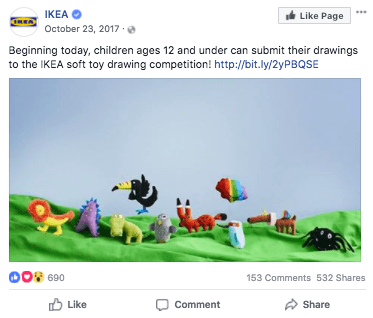
#10 Display external reviews from users
When individuals click on your ad and visit your website, they are likely to investigate your product before making a purchase. Positive external reviews can boost your brand’s credibility and attract new customers. They provide social proof that your products are high-quality and worth purchasing.
Potential customers frequently conduct searches such as:
- “Is Website X a scam?”
- “Product X reviews”
- “Brand X review”
- “Brand X coupons”
Reviews can greatly influence a customer’s decision to buy from you. Encourage happy customers to leave reviews and consider featuring them in your ads.
Dollar Shave Club, a subscription shaving company, excels in advertising. Their Facebook ads stand out for their use of customer reviews in the ad copy. Instead of self-praising, they let satisfied customers vouch for their products. Their informative videos further reassure customers about the product’s effectiveness.
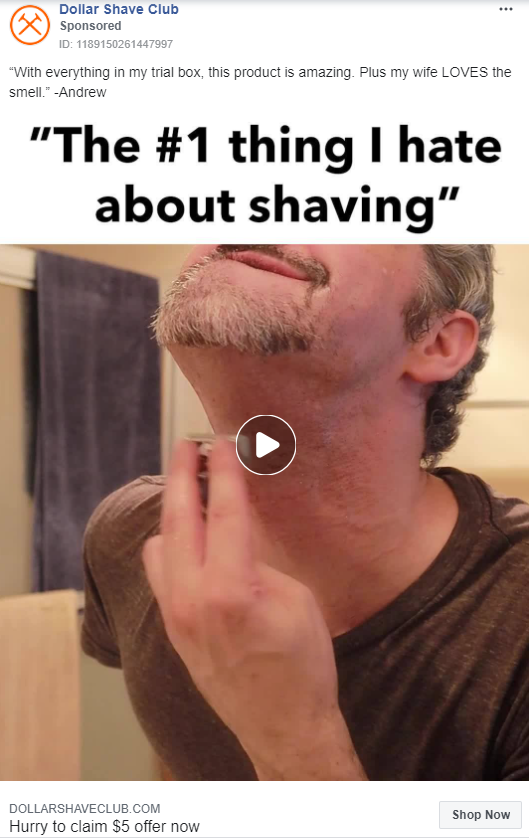
#BONUS Utilize short-form content
Leveraging short-form content is a current trend, with platforms like TikTok leading the way and driving user preference towards bite-sized content. Facebook has not been left behind in this trend, introducing the Reels feature to increase user engagement time.
Reels are more cost-effective and have a higher impression rate compared to other ad placements. In fact, a study showed that Reels see an average reach rate of 30.81%, while carousels and image posts see an average reach rate of 14.45% and 13.14% respectively.
Advertisers should utilize Reels to reach a larger audience, increase engagement, and potentially gain more customers, all while keeping costs low. Don’t miss out on this opportunity to engage with your audience in a new and exciting way.
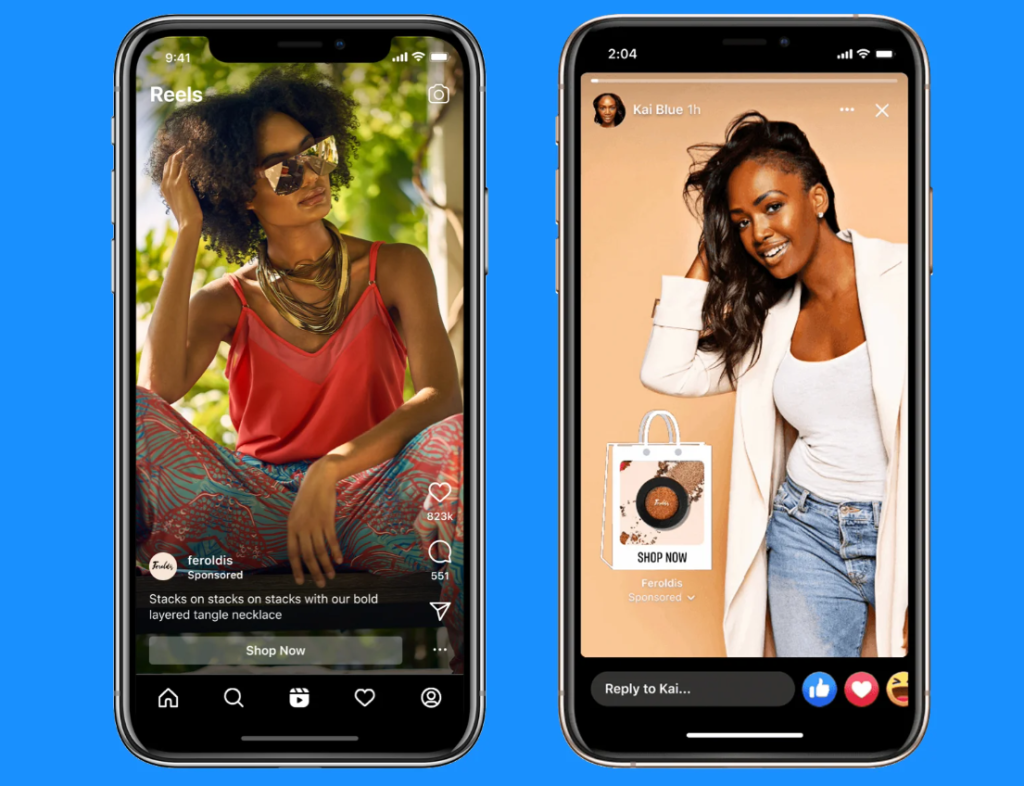
Which Facebook Ads Types are Best for eCommerce?
Facebook offers a variety of ad formats, each catering to different marketing goals. Here are some of the best options to consider for your eCommerce ads:
Carousel Ads
The Carousel Ad format is a top choice for eCommerce Facebook Ads. It’s also highly effective on platforms like Instagram, Messenger, and the Audience Network. These ads enable you to display up to ten images or videos simultaneously, each with its own unique link.
Additionally, Facebook offers an auto-optimization feature that can automatically arrange your carousel images for optimal performance. However, if you’re narrating a story in a specific order, it’s advisable to disable this feature to maintain your desired narrative flow.
What do our experts say?: This ad type is ideal for famous brands and less so for SMEs due to its cost. It’s best used for retargeting once users are familiar with the brand. SMEs should prioritize building brand awareness before investing in this type of advertising.
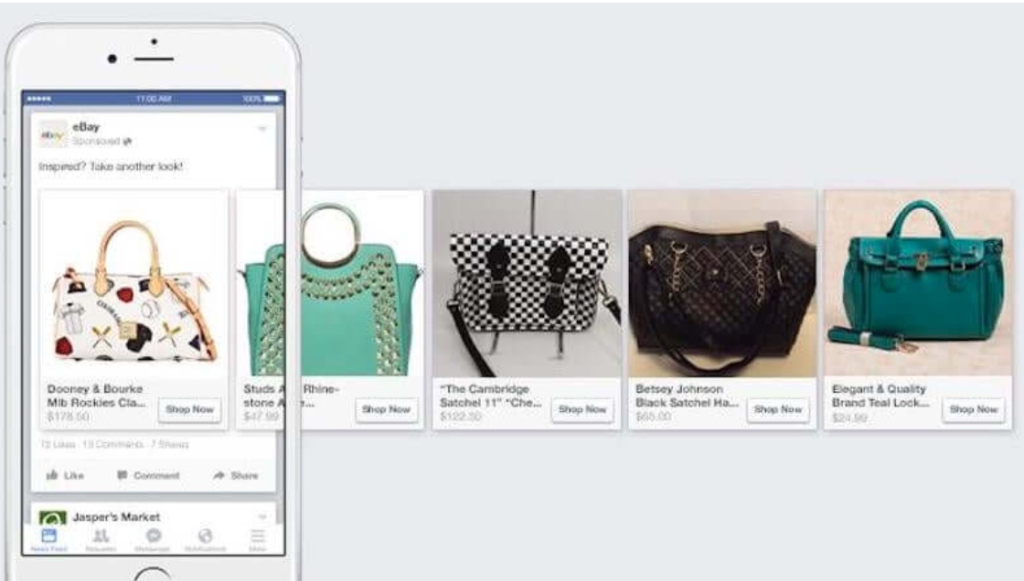
Dynamic Product Ads (DPA)
To put it simply, Dynamic Product Ads are a perfect match for eCommerce. If you have a product catalog, this ad format can be a powerful tool to boost your sales. It automates the promotion of your entire product catalog across Facebook’s platforms, eliminating the need to create numerous individual ads. It also helps you broaden your reach to mobile apps, mobile websites, and videos beyond Facebook.
These ads excel in both cold targeting and retargeting and can be optimized using both the tracking pixel and the Conversions API that we’ve previously discussed.
What do our experts say?: Again, this ad type requires significant investment, both in terms of money and resources, to manage and optimize effectively. Therefore, it is typically more suited to larger businesses with the necessary resources and budget.

Collection Ads
Collection Ads have become a preferred choice for eCommerce businesses. This format is ideal for capturing your audience’s attention while they’re browsing, and is particularly effective for those ready to make a purchase.
Many users discover new products through mobile videos and expect a seamless, quick-loading experience when they decide to explore or buy. Collection Ads cater to this expectation, enabling users to transition from discovery to purchase in just a few clicks. When users tap on your Collection Ad to browse or learn more, they’re directed to a fast-loading visual experience without leaving the platform.
What do our experts say?: Collection ads reduce drop-off rates by providing a seamless, fast-loading experience, especially for mobile users, leading to higher conversions. However, it may not effectively reach desktop users. Besides, advertisers need to constantly do image testing on Facebook, as the right images significantly enhance ad effectiveness.
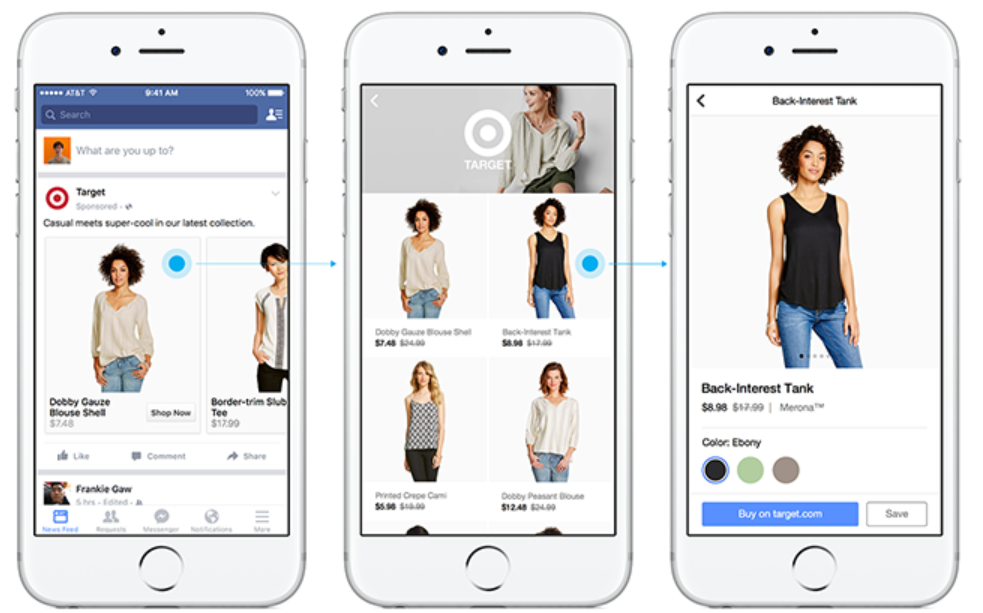
Video Ads
Videos can engage audiences better than static images and most marketers prefer to use them because they result in higher click-through rates (CTR). Video ads can be highly engaging and drive product awareness. Incorporate captivating video ads to showcase product features, highlight customer testimonials, or tell a brand story.
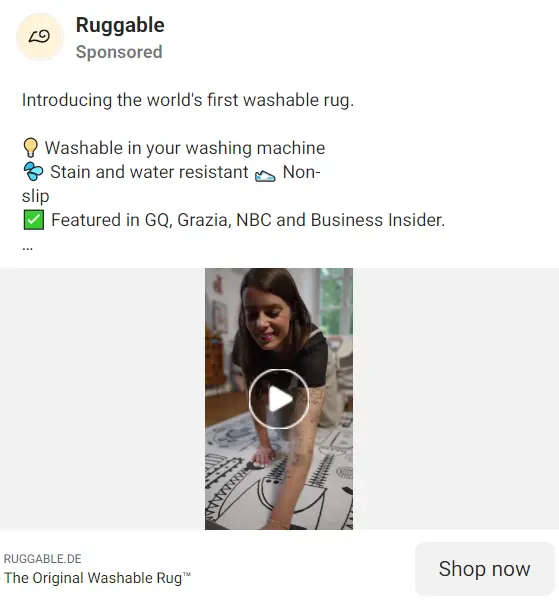
Images Ads
Despite the rise of video, image ads remain a powerful tool for eCommerce businesses, and marketers should never underestimate images. Since you can create them much quicker than videos, you are able to test different creatives more frequently. They’re a great way to showcase your products in a visually appealing way.
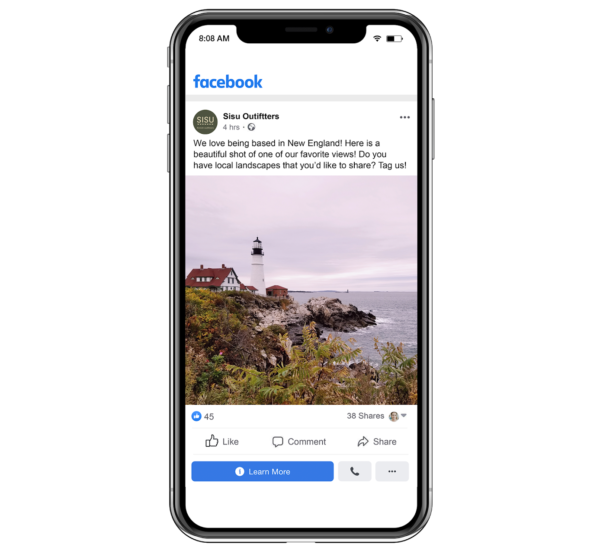
Final words
In conclusion, mastering eCommerce Facebook ads is an essential skill for any business looking to thrive in the digital marketplace. The strategies and insights shared in this article can serve as a roadmap to success, helping you navigate the complexity of Facebook advertising. Remember, the key to successful eCommerce lies in having great products and effectively reaching and engaging your target audience. With eCommerce Facebook ads, you have a powerful tool at your disposal to do just that.







